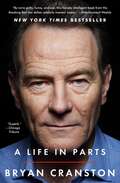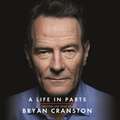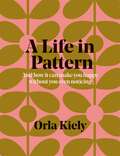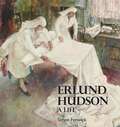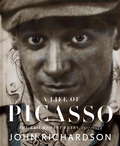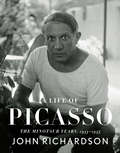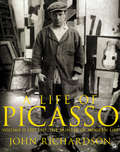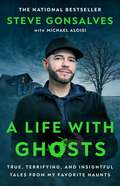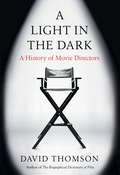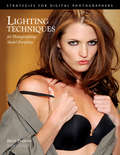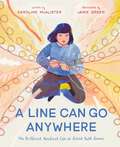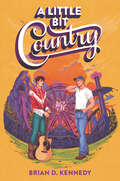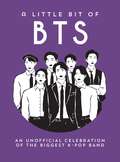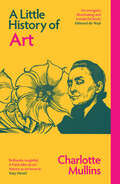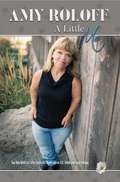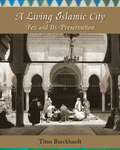- Table View
- List View
A Life in Parts
by Bryan Cranston<P>A poignant, intimate, funny, inspiring memoir--both a coming-of-age story and a meditation on creativity, devotion, and craft--from Bryan Cranston, beloved and acclaimed star of one of history's most successful TV shows, Breaking Bad.Bryan Cranston landed his first role at seven, when his father cast him in a United Way commercial. Acting was clearly the boy's destiny, until one day his father disappeared. Destiny suddenly took a backseat to survival. <P>Now, in his riveting memoir, Cranston maps his zigzag journey from abandoned son to beloved star by recalling the many odd parts he's played in real life--paperboy, farmhand, security guard, dating consultant, murder suspect, dock loader, lover, husband, father. Cranston also chronicles his evolution on camera, from soap opera player trying to master the rules of show business to legendary character actor turning in classic performances as Seinfeld dentist Tim Whatley, "a sadist with newer magazines," and Malcolm in the Middle dad Hal Wilkerson, a lovable bumbler in tighty-whities. He also gives an inspiring account of how he prepared, physically and mentally, for the challenging role of President Lyndon Johnson, a tour de force that won him a Tony to go along with his four Emmys. <P>Of course, Cranston dives deep into the grittiest details of his greatest role, explaining how he searched inward for the personal darkness that would help him create one of the most memorable performances ever captured on screen: Walter White, chemistry teacher turned drug kingpin. Discussing his life as few men do, describing his art as few actors can, Cranston has much to say about creativity, devotion, and craft, as well as innate talent and its challenges and benefits and proper maintenance. But ultimately A Life in Parts is a story about the joy, the necessity, and the transformative power of simple hard work. <P><b>A New York Times Bestseller</b>
A Life in Parts
by Bryan Cranston'Bryan Cranston has created a cinematic record of how an actor shapes a career and an identity and a legacy all at the same time' Tom Hanks'A superb anecdotalist with an honest take on how he dealt with fame found later in life' SUNDAY TIMES CULTUREA poignant, intimate, funny, inspiring memoir - both a coming-of-age story and a meditation on creativity, devotion, and craft - from Bryan Cranston, beloved and acclaimed star of one of history's most successful TV shows, Breaking Bad.Bryan Cranston landed his first role at seven, when his father cast him in a United Way commercial. Acting was clearly the boy's destiny, until one day his father disappeared. Destiny suddenly took a backseat to survival.Now, in his riveting memoir, Cranston maps his zigzag journey from abandoned son to beloved star by recalling the many odd parts he's played in real life - paperboy, farmhand, security guard, dating consultant, murder suspect, dock loader, lover, husband, father. Cranston also chronicles his evolution on camera, from soap opera player trying to master the rules of show business to legendary character actor turning in classic performances as Seinfeld dentist Tim Whatley, "a sadist with newer magazines," and Malcolm in the Middle dad Hal Wilkerson, a lovable bumbler in tighty-whities. He also gives an inspiring account of how he prepared, physically and mentally, for the challenging role of President Lyndon Johnson, a tour de force that won him a Tony to go along with his four Emmys.Of course, Cranston dives deep into the grittiest details of his greatest role, explaining how he searched inward for the personal darkness that would help him create one of the most memorable performances ever captured on screen: Walter White, chemistry teacher turned drug kingpin.Discussing his life as few men do, describing his art as few actors can, Cranston has much to say about creativity, devotion, and craft, as well as innate talent and its challenges and benefits and proper maintenance. But ultimately A Life in Parts is a story about the joy, the necessity, and the transformative power of simple hard work.(p) 2016 Simon & Schuster
A Life in Pattern: And how it can make you happy without you even noticing
by Orla KielyOrla Kiely has opened her archives to explore a life dedicated to print. From her earliest and most iconic pattern, Stem, to the evolution of her print design encompassing the worlds of fashion, homewares and beyond, Orla shares the full range of patterns and designs that she has produced since establishing her brand in 1995.This is a celebration of Orla's entire body of work - of colour, of print and of a handbag loved by women all over the world.Foreword written by Leith Clark, founder of The Violet Book and previously Lula magazine.
A Life in Stitches: Knitting My Way Through Love, Loss, and Laughter
by Rachael HerronIn these 20 heartfelt essays, Rachael Herron celebrated romance novelist by day, 911 dispatcher by night, and founder of the hugely popular blog Yarnagogo.com shows how when life unravels there s always a way to knit it back together again, many times into something even better. Honest, funny, and full of warmth, Herron s tales, each inspired by something she knit or something knit for her, will speak to anyone who has ever picked up a pair of needles. From her very first sweater (a hilarious disaster, to say the least) to the yellow afghan that caused a breakup (and, ultimately, a breakthrough), every piece has a moving story behind it. This beautifully crafted and candid collection is perfect for the knitter who loves to read and the reader who loves to knit.
A Life of Erlund Hudson: A Life (Peridot Press Ser.)
by Simon FenwickErlund Hudson's etchings, sketches and watercolours are nearly always concerned with women at work or at rest, in wartime, domestic or ballet scenes. After a mere 20 years as a professional artist Hudson abandoned painting and became involved in the world of ballet, working as artistic director at the Brooking School of Ballet with Nesta Brooking, her companion of almost 50 years. Although Hudson's output as an artist was relatively small, its significance is shown in that her work can now be found in important collections in Great Britain and North America, including the Imperial War Museum. In this first biography of Eleanor Erlund Hudson (1912-2011) Simon Fenwick creates a moving and informative portrait of the woman and the artist during her long life. The fully illustrated monograph also includes a list of her pictures shown by exhibiting societies during her lifetime.
A Life of Erlund Hudson: A Life (Peridot Press Ser.)
by Simon FenwickErlund Hudson's etchings, sketches and watercolours are nearly always concerned with women at work or at rest, in wartime, domestic or ballet scenes. After a mere 20 years as a professional artist Hudson abandoned painting and became involved in the world of ballet, working as artistic director at the Brooking School of Ballet with Nesta Brooking, her companion of almost 50 years. Although Hudson's output as an artist was relatively small, its significance is shown in that her work can now be found in important collections in Great Britain and North America, including the Imperial War Museum. In this first biography of Eleanor Erlund Hudson (1912-2011) Simon Fenwick creates a moving and informative portrait of the woman and the artist during her long life. The fully illustrated monograph also includes a list of her pictures shown by exhibiting societies during her lifetime.
A Life of Picasso
by John RichardsonJohn Richardson draws on the same combination of lively writing, critical astuteness, exhaustive research, and personal experience which made a bestseller out of the first volume and vividly recreates the artist's life and work during the crucial decade of 1907-17 - a period during which Pablo Picasso and Georges Braque invented Cubism and to that extent engendered modernism. Richardson has had unique access to untapped sources and unpublished material. By harnessing biography to art history, he has managed to crack the code of cubism more successfully than any of his predecessors. And by bringing a fresh light to bear on the artist's often too sensationalised private life, he has succeeded in coming up with a totally new view of this paradoxical man of his paradoxical work. Never before has Picasso's prodigious technique, his incisive vision and not least his sardonic humour been analysed with such clarity.
A Life of Picasso IV: 1933-1943 (A Life of Picasso #4)
by John RichardsonThe beautifully illustrated fourth volume of Picasso&’s life—set in France and Spain during the Spanish Civil War and World War II—covers friendships with the surrealist painters; artistic inspiration around Guernica and the Minotaur; and his muses Marie-Thérèse, Dora Maar, and Françoise Gilot; and much more.Including 271 stunning illustrations and drawing on original and exhaustive research from interviews and never-before-seen material in the Picasso family archives, this book opens with a visit by the Hungarian-French photographer Brassaï to Picasso&’s chateau in Normandy, Boisgeloup, where he would take his iconic photographs of the celebrated plaster busts of Marie-Thérèse, Picasso&’s mistress and muse. Picasso was contributing to André Breton&’s Minotaur magazine and he was also spending more time with the likes of Man Ray, Salvador Dalí, Lee Miller, and the poet Paul Éluard, in Paris as well as in the south of France. It was during this time that Picasso began writing surrealist poetry and became obsessed with the image of himself as the mythic Minotaur—head of a bull, body of a man—and created his most famous etching, Minotauromachie. Richardson shows us the artist is as prolific as ever, painting Marie-Thérèse, but also painting the surrealist photographer Dora Maar who has become a muse, a collaborator and more. In April 1937, the bombing of the town of Guernica during the Spanish Civil War inspires Picasso&’s vast masterwork of the same name, which he paints in just a few weeks for the Spanish Pavilion at the Paris World&’s Fair. When the Nazis occupy Paris in 1940, Picasso chooses to remain in the city despite the threat that his art would be confiscated. In 1943, Picasso meets Françoise Gilot who would replace Dora, and as Richardson writes, &“rejuvenate his psyche, reawaken his imagery and inspire a brilliant sequence of paintings.&” As always, Richardson tells Picasso&’s story through his work during this period, analyzing how it shows what the artist was feeling and thinking. His fascinating and accessible narrative immerses us in one of the most exciting moments in twentieth century cultural history, and brings to a close the definitive and critically acclaimed account of one of the world&’s most celebrated artists.
A Life of Picasso Volume II: 1907 1917: The Painter of Modern Life (Life of Picasso #2)
by John RichardsonJohn Richardson draws on the same combination of lively writing, critical astuteness, exhaustive research, and personal experience which made a bestseller out of the first volume and vividly recreates the artist's life and work during the crucial decade of 1907-17 - a period during which Pablo Picasso and Georges Braque invented Cubism and to that extent engendered modernism. Richardson has had unique access to untapped sources and unpublished material. By harnessing biography to art history, he has managed to crack the code of cubism more successfully than any of his predecessors. And by bringing a fresh light to bear on the artist's often too sensationalised private life, he has succeeded in coming up with a totally new view of this paradoxical man of his paradoxical work. Never before has Picasso's prodigious technique, his incisive vision and not least his sardonic humour been analysed with such clarity.
A Life with Ghosts: True, Terrifying, and Insightful Tales from My Favorite Haunts
by Steve GonsalvesThe official memoir from paranormal investigator and Ghost Hunters TV star Steve Gonsalves!Widely known as a lead investigator on the smash-hit TV series Ghost Hunters as well as Ghost Hunters Academy and the ratings king, Ghost Nation, Steve Gonsalves—already considered to be one of the top paranormal investigators in the world and a pioneer in the industry—showcases a collection of his most meaningful paranormal encounters from some of his favorite haunted locations. Along with the compelling history of each site, Steve recounts his terrifying experiences with disembodied voices, haunting EVPs, mysterious dark masses, and other unexplained phenomena—in addition to what he learned about living through a life with ghosts. His beliefs and theories on the craft of paranormal investigation are told through heartwarming, hilarious, and profound stories, reflecting the fun-loving personality that has garnered him millions of fans. Filled with facts and anecdotes to add an extra level of insight—all intricately woven together to create the perfect balance of unique information and spooky fun—this is the ultimate book for paranormal enthusiasts, history buffs, and horror fans.
A Lifetime in Gatlinburg: Martha Cole Whaley Remembers (American Heritage)
by Marie MaddoxToday, Gatlinburg is an idyllic mountain resort. But the Sugarlands Valley in the 1910s couldn't have been more different. Martha Cole Whaley began her life on the outskirts of the city and has witnessed firsthand the joy and struggle of more than one hundred years in the area. Her rich experiences include what it was like to eat onion tops for an after-school snack, bathe in a washtub behind the stove and see a zipper for the first time on the boots of the mailman. Join author Marie Maddox as she captures an amazing century of Martha's life in Gatlinburg through stories, interviews and even a few of her favorite recipes from now and then.
A Light in the Dark: A History of Movie Directors
by David ThomsonFrom the celebrated film critic and author of The Biographical Dictionary of Film--an essential work on the preeminent, indispensable movie directors and the ways in which their work has forged, and continues to forge, the landscape of modern film.Directors operate behind the scenes, managing actors, establishing a cohesive creative vision, at times literally guiding our eyes with the eye of the camera. But we are often so dazzled by the visions on-screen that it is easy to forget the individual who is off-screen orchestrating the entire production--to say nothing of their having marshaled a script, a studio, and other people's money. David Thomson, in his usual brilliantly insightful way, shines a light on the visionary directors who have shaped modern cinema and, through their work, studies the very nature of film direction. With his customary candor about his own delights and disappointments, Thomson analyzes both landmark works and forgotten films from classic directors such as Orson Welles, Alfred Hitchcock, Jean Renoir, and Jean-Luc Godard, as well as contemporary powerhouses such as Jane Campion, Spike Lee, and Quentin Tarantino. He shrewdly interrogates their professional legacies and influence in the industry, while simultaneously assessing the critical impact of an artist's personal life on his or her work. He explores the male directors' dominance of the past, and describes how diversity can change the landscape. Judicious, vivid, and witty, A Light in the Dark is yet another required Thomson text for every movie lover's shelf.
A Light in the Dark: A History of Movie Directors
by David ThomsonIn little more than a century of cinema - Birth of a Nation was one hundred years old in 2015 - our sense of what a film director is, or should be, has shifted in fascinating ways. A director was once a functionary; then an important but not decisive part of an industrial process; then accepted as the person who was and should be in charge, because he was an artist and a hero. But the world has changed. In a nutshell, the change takes the form of a question: Who directed The Sopranos or Homeland? Hardly anyone knows, because we don't tend to read TV credits and the director has returned to a more subservient and anonymous role. Directors now try to be efficient, the deliverers of profitable films, and are often involved as producers, like Steven Spielberg.David Thomson's brilliant A Light in the Dark personalises each chapter through an individual: Jean Renoir, Howard Hawks, Jean-Luc Godard, Alfred Hitchcock, Luis Bunuel, Orson Welles, Fritz Lang, Jane Campion, Stephen Frears and Quentin Tarantino. Through these characters (and other directors not mentioned here), David Thomson relates an imaginative new history of a medium that has changed the world.
A Lighting Techniques for Photographing Model Portfolios
by Billy PegramDetailed discussions and eye-catching, dynamic images show photographers how to masterfully create beautifully illuminated models in this professional, informative resource. With an endless array of looks for all types of models—such as nude, athletic, advertising, hand, leg, and plus size—this manual is packed with inspiration as well as technical advice Start-to-finish analyses of real-life sessions help photographers take the guesswork out of lighting and avoid common mistakes. Whether enhancing a product with the model or showcasing the model with the photograph, these tips illustrate how to meet objectives through artistry and skill.
A Line Can Go Anywhere: The Brilliant, Resilient Life of Artist Ruth Asawa
by Caroline McAlisterA sweeping picture book biography about influential Japanese-American sculptor Aiko Ruth Asawa and her childhood spent in an incarceration camp, by award-winning author Caroline McAlister and rising star artist Jamie Green.Growing up on a dusty farm in Southern California, Ruth Aiko Asawa lived between two worlds. She was Aiko to some and Ruth to others, an invisible line she balanced on every day.But when Japan bombed Pearl Harbor, suddenly she was only Aiko, no matter how much her family tried to cut the lines that connected them to Japan. Like many other Japanese Americans, Ruth and her family were sent to incarceration camps.At the Santa Anita racetrack, Ruth ran her fingers over the lines of horsehair in the stable stalls the family had moved into. At the Rohwer Relocation Center in Arkansas, she drew what she saw—bayous, guard towers, and the barbed wire that separated her from her old life.That same barbed wire would inspire Ruth’s art for decades, as she grew into one of the most influential artists of the twentieth century. Throughout her career, she created enchanting twisting sculptures and curving shapes that connected, divided, and intersected.This gorgeous biography delves into the magnificent life of Ruth Asawa and her timeless contributions to the art world.
A Line in the Dark
by Malinda Lo<P>The line between best friend and something more is a line always crossed in the dark. <P>Jess Wong is Angie Redmond’s best friend. And that’s the most important thing, even if Angie can’t see how Jess truly feels. Being the girl no one quite notices is OK with Jess anyway. If nobody notices her, she’s free to watch everyone else. <P>But when Angie begins to fall for Margot Adams, a girl from the nearby boarding school, Jess can see it coming a mile away. Suddenly her powers of observation are more a curse than a gift. <P>As Angie drags Jess further into Margot’s circle, Jess discovers more than her friend’s growing crush. Secrets and cruelty lie just beneath the carefree surface of this world of wealth and privilege, and when they come out, Jess knows Angie won’t be able to handle the consequences. <P>When the inevitable darkness finally descends, Angie will need her best friend.
A Little Bit Country
by Brian D. KennedyDumplin' meets Simon vs. the Homo Sapiens Agenda in this heartfelt and funny contemporary romance inspired by Dollywood, about two boys who fall in love against the backdrop of a country music-themed amusement park, from debut author Brian D. Kennedy. Perfect for fans of Erin Hahn, Phil Stamper, and David Levithan.Emmett Maguire wants to be country music’s biggest gay superstar—a far reach when you’re seventeen and living in Illinois. But for now, he’s happy to do the next best thing: Stay with his aunt in Jackson Hollow, Tennessee, for the summer and perform at the amusement park owned by his idol, country legend Wanda Jean Stubbs.Luke Barnes hates country music. As the grandson of Verna Rose, the disgraced singer who had a famous falling out with Wanda Jean, Luke knows how much pain country music has brought his family. But when his mom’s medical bills start piling up, he takes a job at the last place he wants: a restaurant at Wanda World.Neither boy is looking for romance, but sparks fly when they meet—and soon they’re inseparable. Until a long-lost secret about Verna and Wanda comes to light, threatening to unravel everything.Will Emmett and Luke be able get past the truths they discover…or will their relationship go down in history as just another Sad Country Love Song?
A Little Bit of BTS: An Unofficial Celebration of the Biggest K-Pop Band
by Summersdale PublishersStep into the magic shop of BTS and follow them into this delightful book of meaningful quotes, stan-level facts and in-depth trivia for any diehard ARMY. Known for their dynamite stage presence, smooth-like-butter dancing skills and angelic voices, BTS are a K-pop boyband with a message of self-love at the heart of their music.
A Little Book About Art: Quotes for the Aesthete in Your Life
by Orange Hippo!"Art should comfort the disturbed and disturb the comfortable..." - Cesar A. CruzAcross the centuries, art has held up a mirror to humanity's evolving culture and creativity. Ancient civilizations left us mysterious sculptures while Renaissance artists produced iconic masterpieces. The Impressionists captured fleeting moments of beauty, while the Surrealists explored dreams and the subconscious. In recent decades, artists such as Frida Kahlo, Jackson Pollock and Banksy have embraced new mediums and pushed artistic boundaries even further.Brimming with fabulous quotes, this little book offers a window into the minds of some of the world's most admired artists and thinkers - and is a vibrant celebration of the evolution of art through the ages."Life is art. Art is life. I never separate it." - Ai Weiwei
A Little Book About Art: Quotes for the Aesthete in Your Life
by Orange Hippo!"Art should comfort the disturbed and disturb the comfortable..." - Cesar A. CruzAcross the centuries, art has held up a mirror to humanity's evolving culture and creativity. Ancient civilizations left us mysterious sculptures while Renaissance artists produced iconic masterpieces. The Impressionists captured fleeting moments of beauty, while the Surrealists explored dreams and the subconscious. In recent decades, artists such as Frida Kahlo, Jackson Pollock and Banksy have embraced new mediums and pushed artistic boundaries even further.Brimming with fabulous quotes, this little book offers a window into the minds of some of the world's most admired artists and thinkers - and is a vibrant celebration of the evolution of art through the ages."Life is art. Art is life. I never separate it." - Ai Weiwei
A Little Girl Dreams of Taking the Veil
by Dorothea Tanning Max ErnstIn the course of browsing an illustrated book of objects—umbrellas, watches, tools, clothes—artist Max Ernst was struck by the items' unusual juxtapositions. By manipulating the Victorian-era engravings into striking tableaux and adding brief captions, Ernst invented the collage novel and transformed banal advertising art into revealing dramas rooted in his dreams and secret desires. A Little Girl Dreams of Taking the Veil was originally published in 1930 as Rêve d'une petite fille qui voulut entrer au Carmel. Its hallucinatory visions center on the nightmares of a girl who loses her virginity on the day of her first communion and resolves to become a nun. Ernst, a pioneer of the Dada movement and Surrealistic art, blends humor and irony in his exploration of the nonrational but very real intersection of religious ecstasy and erotic desire. A century after its debut, this profoundly peculiar book retains its shock value as well as its imaginative power.
A Little History of Art (Little Histories)
by Charlotte MullinsA thrilling journey through 100,000 years of art, from the first artworks ever made to art&’s central role in culture today &“A fresh take on art history as we know it.&”—Katy Hessel, The Great Women Artists Podcast Charlotte Mullins brings art to life through the stories of those who created it and, importantly, reframes who is included in the narrative to create a more diverse and exciting landscape of art. She shows how art can help us see the world differently and understand our place in it, how it helps us express ourselves, fuels our creativity and contributes to our overall wellbeing and positive mental health. Why did our ancestors make art? What did art mean to them and what does their art mean for us today? Why is art even important at all? Mullins introduces readers to the Terracotta Army and Nok sculptures, Renaissance artists such as Giotto and Michelangelo, trailblazers including Käthe Kollwitz, Pablo Picasso, Frida Kahlo, and contemporary artists who create art as resistance, such as Ai Weiwei and Shirin Neshat. She also restores forgotten artists such as Sofonisba Anguissola, Guan Daosheng and Jacob Lawrence, and travels to the Niger valley, Peru, Java, Rapa Nui and Australia, to broaden our understanding of what art is and should be. This extraordinary journey through 100,000 years celebrates art&’s crucial place in understanding our collective culture and history.
A Little History of Photography Criticism; or, Why Do Photography Critics Hate Photography?
by Susie LinfieldIn A Short History of Photography Criticism; or, Why Do Photography Critics Hate Photography?, Susie Linfield contends that by looking at images of political violence and learning to see the people in them, we engage in an ethically and politically necessary act that connects us to our modern history of violence. For many years, Linfield's acute analysis of photographs--from events as wide-ranging as the Holocaust, the Chinese Cultural Revolution, and recent acts of terrorism--has explored a complex connection between the practices of photojournalism and the rise of human rights ideals. By asking how photography should respond to the darker shadows of modern life, Linfield insists on the continuing moral relevance of photojournalism, while urging us not to avert our eyes from what James Agee once labeled "the cruel radiance of what is. "
A Little Me
by Amy RoloffTLC star Amy shares what it was like growing up with dwarfism, how she struggled to overcome obstacles both physical and emotional while learning, as we all must, to accept herself for who she is. &“God doesn&’t make mistakes.&” For Amy Roloff, star of TLC&’s hit reality show Little People, Big World, her father&’s words would repeatedly serve as an anchor, reminding her of her inherent worth and purpose, whenever feelings of insecurity and inadequacy surfaced and threatened to overwhelm her. In A Little Me, Amy shares what it was like growing up with achondroplasia dwarfism, how she struggled to overcome obstacles both physical and emotional—navigating the average-size world as a little person, dealing with a serious illness as a young girl, bullying, and issues of body image and unachievable beauty ideals—while learning, as we all must, to accept herself for who she is. Finally allowing herself to be vulnerable enough to open up to others, she learned that it&’s worth risking possible rejection for a chance at genuine relationships. Ultimately, it was Amy&’s faith, as well as the support and encouragement of her community of loving family and good friends, that saw her through the dark times and allowed her to realize her greatest dreams and beyond. Amy&’s memoir is an inspiring and at times heart-wrenching account of resilience and the strength of the human spirit to overcome seemingly insurmountable obstacles.
A Living Islamic City: Fez and Its Preservation
by Titus BurckhardtThe Moroccan city of Fez, founded in the ninth century CE, is one of the most precious urban jewels of Islamic civilization. For more than 40 years Titus Burckhardt worked to document and preserve the artistic and architectural heritage of Fez in particular and Morocco in general. These newly translated lectures, delivered while Burckhardt was living and working in Fez, explore how the historic city can be preserved without turning it from a living organism into a dead museum-city, and how it can be adapted and updated using the values that gave birth to the city and its way of life. Aided by photographs and sketches made during the course of his lifetime, Burckhardt conveys what it means to be a living Islamic city.
